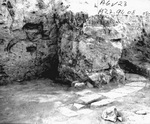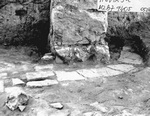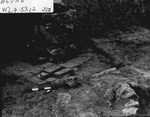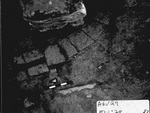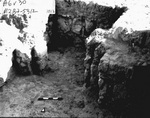A6f74
File: "/MZ/A/A06/D/F/0074.htm".
Processed on 2023-03-22.
| Roster |
Date |
Author |
Record |
| Definition |
1992-07-23 |
RK |
drain. [Input: C7-3.J] |
| Description (summary) |
1992-07-22 |
GVP |
several pieces of chalky conglomerate varying in size from 4 to 14 cm; material contains many small aquatic type shells; not well compacted in that it has a significant number of noticeable voids; the cementing material is a nearly white substance. [Input: C7-3.J] |
| 1992-07-23 |
RK |
opening at N curving toward SSE around wall, f72 -- narrow trough, 58x9.5 at N end, blocked/bound by a fired brick 34x16.5 at the N side -- there is an extra brick piece to the E paralleled by another where the open trough ends in line with the N face of wall, f72. -- At the E end now visible, there a rock instead of the fired brick over the drain, at the current position of the E baulk. [Input: C7-3.J] |
| Roster |
Date |
Author |
Record |
| Strategy (projected or implemented) |
1992-07-26 |
GB |
full excavation of the drain will hopefully lead us to the outer perimeter of the building. [Input: C7-3.J] |
| Notes on recovery |
1992-07-22 |
RK |
the sample was obtained from f67, the plastered stone layer and is part of the plaster [Input: C7-3.J] |
| 1992-07-26 |
GB |
we will try to get a snake to follow drain as far as possible, as suggested by Gabe Pesce. But one should be careful about possible objects; stopping point may mean just an occlusion. [Input: C7-3.J] |
| 1992-07-26 |
RK |
The drain seems to be occluded. A miniature snake could be be inserted past 40cm of its length into the drain. [Input: C7-3.J] |
| Roster |
Date |
Author |
Record |
| Locus |
1992-07-23 |
rK |
k170 [Input: ZGx10aMA.j] |
| Notes on volumetric localization |
1992-07-28 |
GB |
elevation: of floor E of drain: m1275-83 -- first brick over the drain, past the opening: m1273-162 -- last brick before the stone over the drain, adjoining the E baulk (i.e., brick # 6): m1273-163 [Input: C7-3.J] |
| Roster |
Date |
Author |
Record |
| Inclination |
1992-07-26 |
GB |
even though top bricks seem to sope down towards the opening in the North, the actual sope of the drain surface is in the opposite direction -- Gabe Pesce will measure inclination [Input: C7-3.J] |
| Orientation |
1992-07-26 |
GB |
the drain takes water out of the building towards the SE. This upslope in terms of the present profile of the mound, and to some extent it may have been the same in antiquity, i.e., the general sope of would have been up towards the center of the city (i.e, towards BA). hence, the curve to the East may have to be explained on the basis of the following: (1) adapation to existing structural limitations of thebuilding (avoiding large wells); (2) need to link different rooms/courtyards; (3) discharge to a septic tank rather than to the street. [Input: C7-3.J] |
| Notes on axial definition |
1992-07-26 |
GB |
drain goes through doorway, and opening is just in the middle of the doorway, just to the N of the threshold. This seems a bit odd in terms of circulation. It may be that it was important to keep room of the South free of water from the adjoining spaces to the North. [Input: C7-3.J] |
| 1992-07-26 |
GB |
since the top of this drain is rather carefully laid with baked bricks, we should presume that it corresponds to a well defined floor surface on either side. The mud brick in the threshold (see a2: cp) would be part of it. [Input: C7-3.J] |
| Roster |
Date |
Author |
Record |
| Components (within element) |
1992-07-22 |
RK |
It seems to be a crude form of lime mortal made from snail shells -- note: oyster shells are a standard source for lime in the making of mortar. [Input: C7-3.J] |
| 1992-07-23 |
RK |
covered by fired bricks 31x33 cm max dim. and broken pieces of bricks; appear to be square bricks shaped for the curves. The smallest pieces do not have unbroken edges shorter than the smallest dimension of the intact ones. [Input: C7-3.J] |
| 1992-07-26 |
GB |
two layers of backed brick ( x x cms) on the sides, covered by irregular baked bricks after the initial opening; one baked brick at the bottom. -- some dirt compacted at the bottom, otherwise open in the upper part. [Input: C7-3.J] |
| Texture, surface finish |
1992-07-23 |
rK |
fired limestone -drainage? [Input: ZGx10aMA.j] |
| Notes on typology |
1992-07-28 |
GB |
the ground adjoining the drain to the NE is bricky red and may consist of packing. The fact that it is not green may suggest that it was not used for bathing type purposes (?) [Input: C7-3.J] |
| Roster |
Date |
Author |
Record |
| Evidence |
1992-07-26 |
GB |
this is obviously a discharge drain for dirty water [Input: C7-3.J] |
